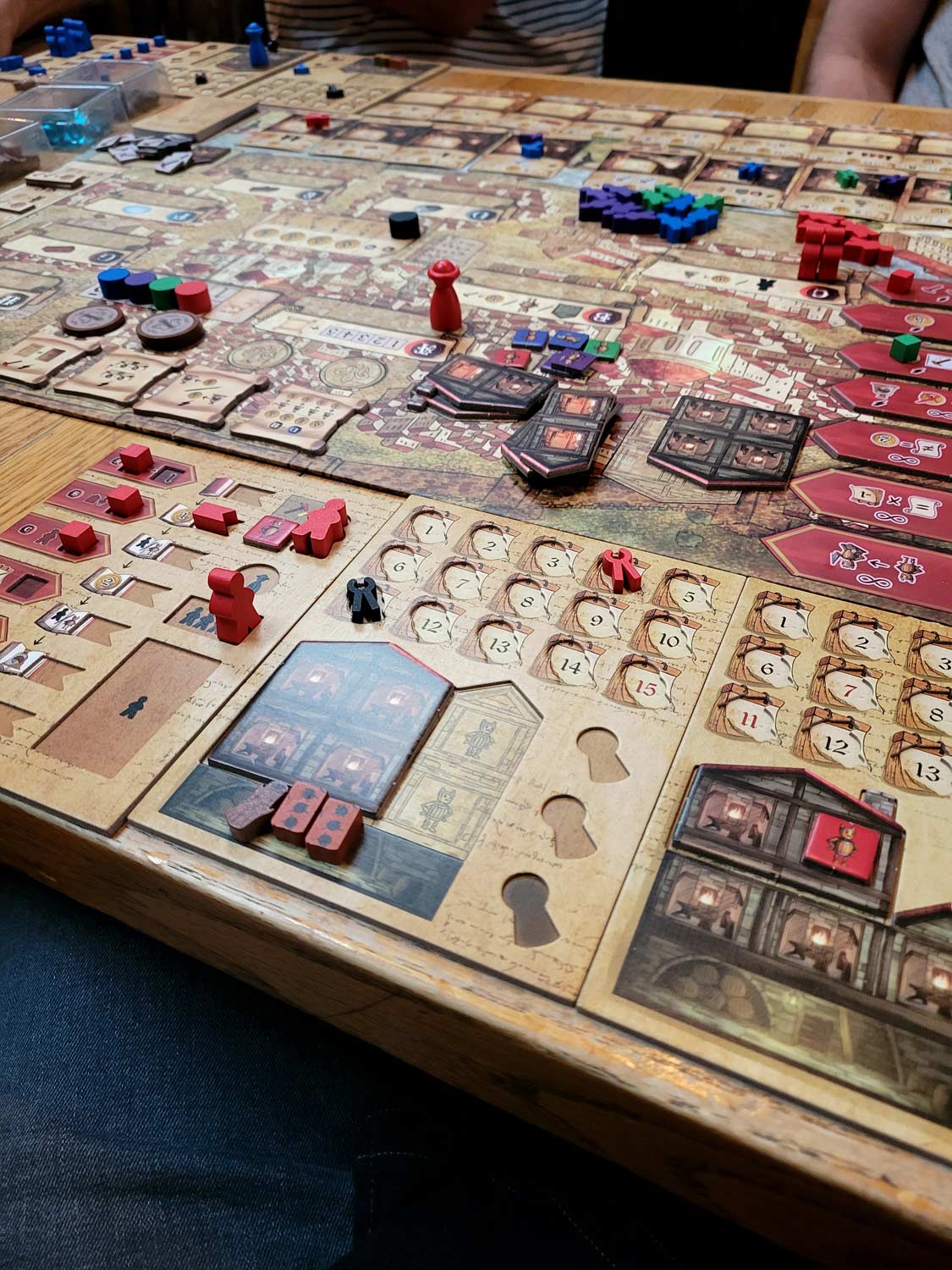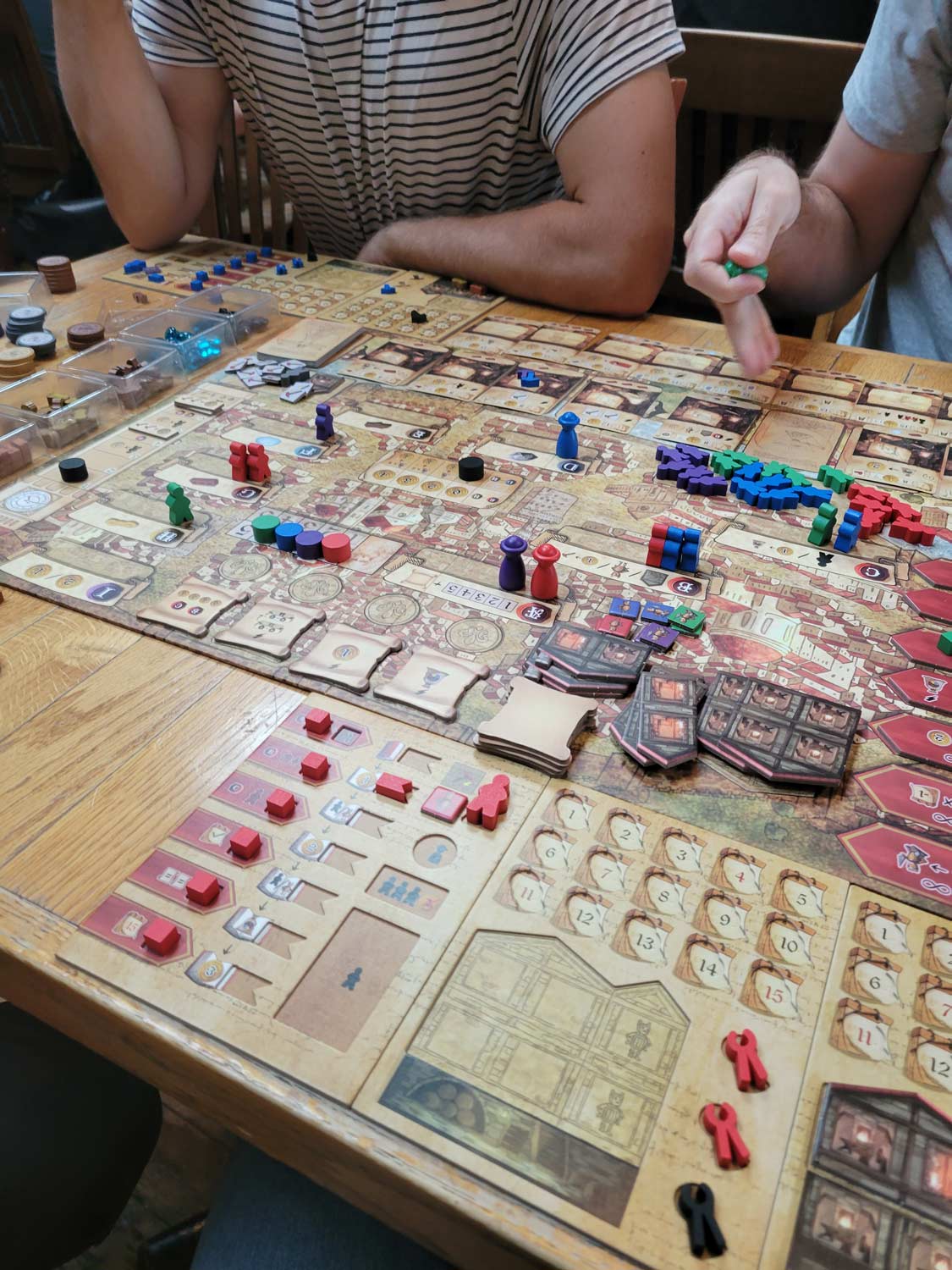Disclosure: Meeple Mountain received a free copy of this product in exchange for an honest, unbiased review. This review is not intended to be an endorsement.
Admittedly, my tastes bend toward austere-looking games with a brown color palette, so I’m naturally predisposed to like a game that features tan, olive, brown, beige, ochre, and a smattering of puce. That said, this sucker has quite a lot going on under the hood.
This game is a reimplementation of one of the earliest published designs of Acchittocca (the design team of Flaminia Brasini, Virginio Gigli, Stefano Luperto, and Antonio Tinto–collectively responsible for Alma Mater, Egizia: Shifting Sands, and several other games in loose collaboration), Leonardo da Vinci. Codex Leicester has one more designer thrown in the mix for good measure, Changhyun Baek.
I haven’t played the original game, so you won’t find any comparing and contrasting here, though there are significant differences between this version of the game and the original, or at least that’s the sense I get from reading the original game’s rules.
But here’s a thousand-foot summary. Codex Leicester is a worker placement game with a high degree of interaction. Players start with a single workshop, which can be upgraded with various bits and bobs to make it more powerful, and they can also add a second workshop as the game moves forward.

What do you do with these workshops? Produce inventions. There’s a display featuring cards that represent said inventions. In the first phase of each round (of which there are 7), players declare, in reverse turn order, whichinventions they’re going to try and produce. To declare an invention, you must have an empty workshop and the resources necessary to start work. Then, you put a player marker on the invention, and set a tracker on your workshop at 4,7,11, or 15, depending on the difficulty of the invention. You have to get another tracker to meet or cross that threshold to complete the invention and take the card, which will give you some money (points), a special ability or boon, and a symbol, which is for endgame scoring.
Because you only have two workshops, you’ll only ever be able to work on two inventions at a time. Plus, some of the inventions in the display are considered “future” inventions (the ones later in the queue), and cannot be completed until they enter the present area of the display. So, you can work on something, but won’t necessarily get to finish it until it moves far enough up in the queue. On top of this, players can work on the same inventions, and the rewards are significantly better for the person who completes the invention first.
After players declare their inventions, there is a worker placement phase, which functions like an auction. Players have a super worker that is worth two influence, and regular workers that are worth one influence. In turn order, players can place as many regular workers as they desire onto a worker placement space, place their super worker, or add regular workers to a space that has only their super worker already. Regular workers can’t be added to spaces with regular workers of your own there already though, making the process tense and surgical.
Why does the influence matter? It’s not just that you get to go first if you have the most, but for most of the action spaces, it becomes increasingly expensive to use the space—and each space can only be activated four times. So, a crowded spot might result in people not getting exactly what they bargained for because their hybrid placement/bid wasn’t aggressive enough.

Players also place their workers in their own workshops to attempt to complete their declared inventions.
And while there’s some other familiar modern eurogame trappings, including a player board where you unlock bonuses, a bit of endgame set collection, and a small amount of engine building, that’s the gist of it.
What I like about Codex Leicester is that it manages to be a well-engineered contest. There aren’t any catch up mechanisms for players that fall behind, so players must balance the needs of getting money to do things and conserving money for points. The action system is cool, forcing players to readjust and play sub-optimally because of direct and meaningful “attacks” from their opponents. This makes the game a little fragile, mainly because there are no balancing mechanisms in place, meaning that if you don’t acquire more workers, you will fall behind players that do. You need to keep pace with the economies of the other players while also making big moves yourself.
This is where the theme actually shines for me. The setting is bog-standard euro renaissance stuff, but the game feels like you’re in a race to invent the best things the fastest, while jockeying with other would-be inventors for space, which I appreciated.
And the production is excellent. I’m a long-time fan of DiceTree Games. Their versions of Modern Art and Winner’s Circle both are what I consider to be the ultimate versions of those games, and the little details of the production really shine–vibrant player colors, unwarped dual-layer player boards, detailed resources, and a storage system that actually works. Playing this has me hotly anticipating their rerelease of The Scepter of Zavandor.
If any of this sounds interesting, I highly encourage you to give the game a shot. As far as I know, DiceTree only sells to the US through Amazon, and the games are reasonably priced., I think they do small print runs, though, so get a copy while you can and get inventing!












Add Comment